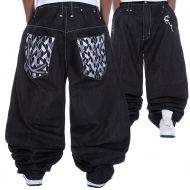 | ||
Wide-leg jeans or baggy pants are a style of clothing popular from the mid-1990s until the mid-2000s. The quintessential brand of "hip-hop" style wide leg jeans was JNCO, though other youth and ethnic oriented clothing companies manufacture them as well.
Contents
History
Historically, the cut of pants has varied by period. From the 1500s until the early 17th century, very loose fitting breeches and hosen were fashionable among the wealthy. Frequently, these galligaskins, trunk hose and Rhinegraves had slits to reveal a contrasting fabric lining, and were paired with short doublet or jerkin. These were replaced with tighter breeches and justacorps frock coats during the 1660s, which remained in fashion until long pantaloons were introduced during the 1788 French Revolution and Georgian Regency era. Baggy pantaloons (named after Pantalone from the Harlequinade) were originally work clothing, and were worn by urban French Sans-Culottes seeking to distinguish themselves from the overdressed aristocratic fops of the Ancien Régime who wore tight knee breeches.
In the Islamic World, loose fitting harem pants and the shalwar kameez were traditionally worn for modesty. These trousers remain typical everyday menswear in modern Iran, Afghanistan and Kurdistan. Subsequent conflict between the Ottoman, Russian and Holy Roman Empire resulted in the development of the European loose trousers or Sharovary worn as folk costume in Greece, Bulgaria, Hungary, Poland and Ukraine. From the Crimean War until World War I, French Zouaves were also issued baggy red pajama pants inspired by those worn by North African and Turkish soldiers.
Beginning in the early 20th century, baggy pants began to gain rebellious connotations. During the 1920s, wide Oxford bags were favored by the Hearties of Oxford and Cambridge University because they could be put on over the knickerbockers then worn to play rugby football. In the US during the 1930s and 1940s, Black, Italian and Mexican zoot suiters, Pachuchos and hep cats wore very wide legged high waisted pants to the dancehalls as a protest against wartime rationing, and because it was easy for gang members to conceal weapons beneath a baggy suit. The popularity of baggy pants among teenagers faded in the 1950s, when young members of the greaser subculture favored drainpipe jeans.
In modern fashion
Baggy jeans were widely worn by West Coast surfers and members of the late 1960s counterculture: old Levi Strauss jeans cut down and bleached by the sea air. In the 1970s bell bottom trousers were worn by hippies and disco fans, but modern-day baggy jeans originated in the ghetto, where African American children had to wear secondhand clothes, often handed down from an older sibling or cousin.
In the 1980s, baggy jeans entered mainstream fashion as the Hammer pants and parachute pants worn by rappers to facilitate breakdancing. In the 1990s these jeans became even baggier and were worn by skaters, hardcore punks, ravers and rappers to set themselves apart from the skintight acid wash drainpipe jeans worn by metalheads. They were largely an underground trend in the early 1990s, but took off in popularity in the mid-1990s. They continued to be popular in the 2000s, but by 2003 baggy jeans started to be replaced by boot-cut jeans and trousers among white men. However, they continued to be popular among African-American and Latino men throughout the mid 2000s until about 2008.
In the United Kingdom, during the 1990s fad they were known as "baggies". However, this term faded with the original fad and now they are generally known as "wide-leg jeans".
In the late 2000s, Rap stars like Kanye West popularised a more refined indie-inspired look but baggy jeans continue to be worn by the raver and gangsta rap subcultures.
Dimensions
Wide-leg jeans and pants are at least 20" in circumference at the hem. Wide-leg jeans differ from bell-bottoms in that the entire length of the leg is large in circumference whereas flare or bell-bottom jeans become wider below the knee. Wide-leg jeans can be considered to be a variant of baggy jeans, which were also popular in the 1990s.
Super wide-leg jeans have a circumference at the hem of 23" to 26"; whereas, extreme wide-leg jeans are greater than 26".
